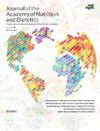Measured and Predicted Resting Metabolic Rate of Dutch and Norwegian Paralympic Athletes
IF 4
2区 医学
Q2 NUTRITION & DIETETICS
Journal of the Academy of Nutrition and Dietetics
Pub Date : 2025-02-01
DOI:10.1016/j.jand.2024.05.010
引用次数: 0
Abstract
Background
Although resting metabolic rate (RMR) is crucial for understanding athletes’ energy requirements, limited information is available on the RMR of Paralympic athletes.
Objective
The aim of this study was to determine RMR and its predictors in a diverse cohort of Paralympic athletes and evaluate the agreement between measured and predicted RMR from both newly developed and pre-existing equations.
Design
This cross-sectional study, conducted between September 2020 and September 2022 in the Netherlands and Norway, assessed RMR in Paralympic athletes by means of ventilated hood indirect calorimetry and body composition by means of dual-energy x-ray absorptiometry.
Participants
Sixty-seven Paralympic athletes (male: n = 37; female: n = 30) competing in various sports, with a spinal cord disorder (n = 22), neurologic condition (n = 8), limb deficiency (n = 18), visual or hearing impairment (n = 7), or other disability (n = 12) participated.
Main outcome measures
RMR, fat-free mass (FFM), body mass, and triiodothyronine (T3) concentrations were assessed.
Statistical analyses
Multiple regression analyses were conducted with height, FFM, body mass, sex, T3 concentration, and disabilities as potential predictors of RMR. Differences between measured and predicted RMRs were analyzed for individual accuracy, root mean square error, and intraclass correlation.
Results
Mean ± SD RMR was 1386 ± 258 kcal/d for females and 1686 ± 302 kcal/d for males. Regression analysis identified FFM, T3 concentrations, and the presence of a spinal cord disorder, as the main predictors of RMR (adjusted R2 = 0.71; F = 50.3; P < .001). The novel prediction equations based on these data, as well as pre-existing equations of Chun and colleagues and Nightingale and Gorgey performed well on accuracy (>60% of participants within 10% of measured RMR), had good reliability (intraclass correlation >0.78), and low root mean square error (≤141 kcal).
Conclusions
FFM, total T3 concentrations, and presence of spinal cord disorder are the main predictors of RMR in Paralympic athletes. Both the current study’s prediction equations and those from Chun and colleagues and Nightingale and Gorgey align well with measured RMR, offering accurate prediction equations for the RMR of Paralympic athletes.
荷兰和挪威残奥会运动员的静息代谢率测量值和预测值。
背景:静息代谢率(RMR)对于了解运动员的能量需求至关重要,但有关残奥会运动员静息代谢率的信息却十分有限:目的:确定残奥会运动员群体的静息代谢率及其预测指标,并评估根据新开发的方程和现有方程测得的静息代谢率与预测的静息代谢率之间的一致性:这项横断面研究于 2020 年 9 月至 2022 年 9 月期间在荷兰和挪威进行,通过通风罩间接热量测定法评估残奥会运动员的 RMR,并通过双能 X 射线吸收测定法评估身体成分:67 名残奥会运动员(男:n=37;女:n=30)参加了不同项目的比赛,他们患有脊髓疾病(SCD;n=22)、神经系统疾病(n=8)、肢体缺陷(n=18)、视力或听力障碍(n=7)或其他残疾(n=12):评估RMR、去脂质量(FFM)、体质量和三碘甲状腺原氨酸(T3)浓度:将身高、去脂质量、体重、性别、T3 浓度和残疾情况作为 RMR 的潜在预测因素,进行了多元回归分析。对测量值和预测值之间的差异进行了个体准确性、均方根误差(RMSE)和类内相关性(ICC)分析:女性的平均 RMR 为 1386±258 千卡/天,男性为 1686±302 千卡/天。回归分析表明,FFM、T3 浓度和脊髓疾病(SCD)是 RMR 的主要预测因素(调整后 R2=0.71;F=50.3;P60% 的参与者的 RMR 在测量值的 10%以内),具有良好的可靠性(ICC >0.78)和较低的 RMSE(≤141 千卡):结论:FFM、总 T3 浓度和是否患有 SCD 是预测残奥会运动员 RMR 的主要因素。本研究的预测方程和 Chun 等人以及 Nightingale 和 Gorgey 的预测方程都与测量的 RMR 非常吻合,为残奥会运动员的 RMR 提供了准确的预测方程。
本文章由计算机程序翻译,如有差异,请以英文原文为准。
求助全文
约1分钟内获得全文
求助全文
来源期刊

Journal of the Academy of Nutrition and Dietetics
NUTRITION & DIETETICS-
CiteScore
7.20
自引率
10.40%
发文量
649
审稿时长
68 days
期刊介绍:
The Journal of the Academy of Nutrition and Dietetics is the premier source for the practice and science of food, nutrition, and dietetics. The monthly, peer-reviewed journal presents original articles prepared by scholars and practitioners and is the most widely read professional publication in the field. The Journal focuses on advancing professional knowledge across the range of research and practice issues such as: nutritional science, medical nutrition therapy, public health nutrition, food science and biotechnology, foodservice systems, leadership and management, and dietetics education.
 求助内容:
求助内容: 应助结果提醒方式:
应助结果提醒方式:


